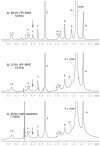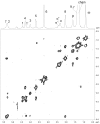An improved NMR study of liposomes using 1-palmitoyl-2-oleoyl-sn-glycero-3-phospatidylcholine as model
- PMID: 17962765
- PMCID: PMC6148493
- DOI: 10.3390/11050334
An improved NMR study of liposomes using 1-palmitoyl-2-oleoyl-sn-glycero-3-phospatidylcholine as model
Abstract
In this paper we report a comparative characterization of Small Unilamellar Vesicles (SUVs), Large Unilamellar Vesicles (LUVs) and Multilamellar Vesicles (MLVs) prepared from 1-palmitoyl-2-oleoyl-sn-glycero-3-phospatidylcholine (POPC), carried out using two NMR techniques, namely High Resolution NMR in solution and High Resolution-Magic Angle Spinning (HR-MAS). The size and size distributions of these vesicles were investigated using the dynamic light scattering technique. An improved assignment of the (1)H-NMR spectrum of MLVs is also reported.
Figures




Similar articles
-
Multilamellar liposomes formed by phosphatidyl nucleosides: an NMR-HR-MAS characterization.Langmuir. 2004 Feb 17;20(4):1144-51. doi: 10.1021/la035804h. Langmuir. 2004. PMID: 15803689
-
Aluminum binding to phosphatidylcholine lipid bilayer membranes: 27Al and 31P NMR spectroscopic studies.Chem Phys Lipids. 2004 Nov;132(1):23-36. doi: 10.1016/j.chemphyslip.2004.09.003. Chem Phys Lipids. 2004. PMID: 15530445
-
Studies of phospholipid hydration by high-resolution magic-angle spinning nuclear magnetic resonance.Biophys J. 1999 Jan;76(1 Pt 1):387-99. doi: 10.1016/S0006-3495(99)77205-X. Biophys J. 1999. PMID: 9876150 Free PMC article.
-
Multi-dimensional pulsed field gradient magic angle spinning NMR experiments on membranes.Magn Reson Chem. 2004 Feb;42(2):115-22. doi: 10.1002/mrc.1329. Magn Reson Chem. 2004. PMID: 14745790
-
Calcein release behavior from liposomal bilayer; influence of physicochemical/mechanical/structural properties of lipids.Biochimie. 2013 Nov;95(11):2018-33. doi: 10.1016/j.biochi.2013.07.006. Epub 2013 Jul 16. Biochimie. 2013. PMID: 23871914
Cited by
-
Mechanisms of action of (meth)acrylates in hemolytic activity, in vivo toxicity and dipalmitoylphosphatidylcholine (DPPC) liposomes determined using NMR spectroscopy.Int J Mol Sci. 2012;13(1):758-773. doi: 10.3390/ijms13010758. Epub 2012 Jan 12. Int J Mol Sci. 2012. PMID: 22312284 Free PMC article.
-
Methods of Liposomes Preparation: Formation and Control Factors of Versatile Nanocarriers for Biomedical and Nanomedicine Application.Pharmaceutics. 2022 Feb 28;14(3):543. doi: 10.3390/pharmaceutics14030543. Pharmaceutics. 2022. PMID: 35335920 Free PMC article. Review.
-
Structural molecular details of the endocytic adaptor protein CALM upon binding with phosphatidylinositol 4,5-bisphosphate-containing model membranes.Commun Chem. 2025 Jul 29;8(1):219. doi: 10.1038/s42004-025-01590-3. Commun Chem. 2025. PMID: 40730637 Free PMC article.
-
Basic Methods for Preparation of Liposomes and Studying Their Interactions with Different Compounds, with the Emphasis on Polyphenols.Int J Mol Sci. 2021 Jun 18;22(12):6547. doi: 10.3390/ijms22126547. Int J Mol Sci. 2021. PMID: 34207189 Free PMC article. Review.
-
Exploring the sensitivities of experimental techniques to various types of membrane asymmetry using atomistic simulations.Faraday Discuss. 2025 Aug 13;259(0):300-320. doi: 10.1039/d4fd00200h. Faraday Discuss. 2025. PMID: 40338116 Free PMC article.
References
-
- Lasic D.D. Liposomes from Physics to Applications. Elsevier; Amsterdam: 1993.
-
- Gregoriadis G. Engineering liposomes for drug delivery: progress and problems. TIBTECH. 1995;13:527–537. - PubMed
MeSH terms
Substances
LinkOut - more resources
Full Text Sources

